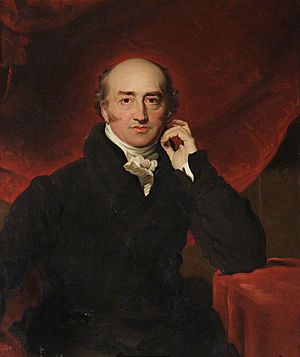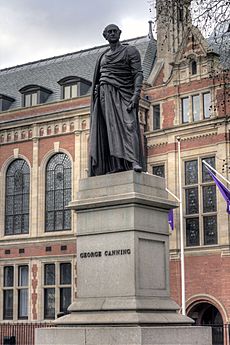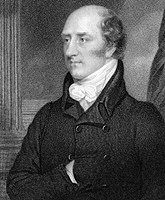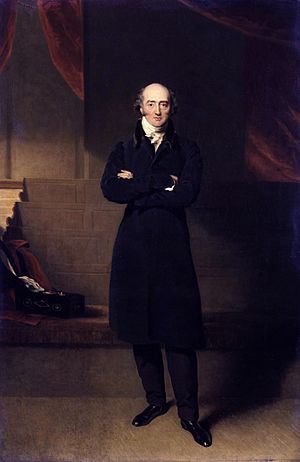George Canning facts for kids
Quick facts for kids
George Canning
|
|
|---|---|

Portrait by Thomas Lawrence (1822)
|
|
| Prime Minister of the United Kingdom | |
| In office 12 April 1827 – 8 August 1827 |
|
| Monarch | George IV |
| Preceded by | The Earl of Liverpool |
| Succeeded by | The Viscount Goderich |
| Chancellor of the Exchequer | |
| In office 20 April 1827 – 8 August 1827 |
|
| Prime Minister | Himself |
| Preceded by | F. J. Robinson |
| Succeeded by | John Charles Herries |
| Foreign Secretary | |
| In office 16 September 1822 – 20 April 1827 |
|
| Prime Minister | The Earl of Liverpool; Himself |
| Preceded by | The Marquess of Londonderry |
| Succeeded by | The Viscount Dudley and Ward |
| In office 25 March 1807 – 11 October 1809 |
|
| Prime Minister | The Duke of Portland |
| Preceded by | Viscount Howick |
| Succeeded by | The Earl Bathurst |
| Leader of the House of Commons | |
| In office 16 September 1822 – 20 April 1827 |
|
| Prime Minister | The Earl of Liverpool; Himself |
| Preceded by | The Marquess of Londonderry |
| Succeeded by | William Huskisson |
| President of the Board of Control | |
| In office 20 June 1816 – 16 January 1821 |
|
| Prime Minister | The Earl of Liverpool |
| Preceded by | The Earl of Buckinghamshire |
| Succeeded by | Charles Bathurst |
| British Ambassador to Portugal | |
| In office October 1814 – June 1815 |
|
| Appointed by | The Prince Regent |
| Preceded by | Sir Charles Stuart |
| Succeeded by | Thomas Sydenham |
| Treasurer of the Navy | |
| In office 14 May 1804 – 23 January 1806 |
|
| Prime Minister | William Pitt the Younger |
| Preceded by | George Tierney |
| Succeeded by | Richard Brinsley Sheridan |
| Paymaster of the Forces | |
| In office 5 July 1800 – 26 March 1801 |
|
| Prime Minister | William Pitt the Younger |
| Preceded by | Dudley Ryder |
| Succeeded by | The Lord Glenbervie |
| Personal details | |
| Born | 11 April 1770 Marylebone, Middlesex, England |
| Died | 8 August 1827 (aged 57) Chiswick, Middlesex, England |
| Resting place | Westminster Abbey |
| Political party | Tory |
| Spouse |
Joan Scott
(m. 1800) |
| Children | 4 |
| Parents |
|
| Alma mater | Christ Church, Oxford |
| Signature | |
George Canning (born 11 April 1770, died 8 August 1827) was an important British politician from the Tory party. He held many high-ranking jobs in the government. He was the Foreign Secretary twice, which meant he handled Britain's relationships with other countries. He then became Prime Minister of the United Kingdom for the last 119 days of his life, from April to August 1827.
George Canning came from a family with little money. His uncle, Stratford Canning, helped him financially. This allowed George to go to top schools like Eton College and Christ Church, Oxford. He started his political career in 1793 and quickly became well-known. He worked under William Pitt the Younger as Paymaster of the Forces and Treasurer of the Navy.
Later, as Foreign Secretary, Canning made big decisions during the Napoleonic Wars. He ordered the capture of the Danish fleet in 1807 to make sure Britain's navy stayed stronger than Napoleon's. In 1809, he was hurt in a duel with another politician, Lord Castlereagh. After this, he was out of government for a few years.
Canning returned to government under Prime Minister the Earl of Liverpool. He served as British Ambassador to Portugal, President of the Board of Control, and again as Foreign Secretary. He also became Leader of the House of Commons, which is a very important role in Parliament. Even though King George IV didn't like him, Canning was very popular with the public. He was successful in helping countries in South America, like Brazil and the former Spanish colonies, become independent. This also helped British businesses trade more easily.
When Lord Liverpool retired in 1827, Canning became Prime Minister. But some important politicians, like the Duke of Wellington and Sir Robert Peel, refused to work with him. This caused the Tory party to split. Canning then invited some Whigs to join his government. Sadly, his health got worse, and he died of pneumonia on 8 August 1827. He was Prime Minister for only 119 days, making him one of the shortest-serving prime ministers in British history.
Contents
- Early Life and Education
- Starting a Political Career
- Early Government Roles
- Time Out of Office
- Treasurer of the Navy
- Foreign Secretary: First Term
- Later Government Roles
- Foreign Secretary and Leader of the House: Second Term
- Prime Minister
- Legacy
- Places Named After George Canning
- Family Life
- Images for kids
- See also
Early Life and Education
George Canning was born in London on 11 April 1770. His family was Anglo-Irish. His father, also named George Canning, was a writer and lawyer who didn't have much money. He died when George was only one year old. George's mother, Mary Ann Costello, became an actress. At that time, being an actress was not seen as a very respectable job. Later, when George Canning was about to become Prime Minister, some people criticized him because his mother was an actress.
Because young George was very smart, family friends convinced his uncle, Stratford Canning, to take care of him. George grew up with his cousins and his uncle paid for his education. This allowed him to attend famous schools like Eton College and Christ Church, Oxford. He was an excellent student at Eton, especially in classical studies, and was known for his public speaking.
At Oxford, Canning won a prize for a Latin poem. After finishing his studies in 1791, he started training to be a lawyer. However, he really wanted to get into politics.
Starting a Political Career
George Canning's uncle was a Whig, a political group that often included wealthy landowners. Through his uncle, George met important Whig leaders like Charles James Fox and Edmund Burke.
However, Canning didn't have much money or a powerful family name, which made it hard to rise in the Whig party. In the early 1790s, he became more conservative after seeing the extreme changes of the French Revolution. He then decided to join the "Tory" group, led by William Pitt the Younger.
In 1793, with Pitt's help, Canning became a member of Parliament for Newtown. This was a "rotten borough," meaning it was a small town with very few voters, so it was easy to get elected there. He later represented other areas during his time in Parliament.
Canning quickly became known as a powerful speaker and writer. His speeches and essays helped Pitt's supporters explain their ideas better. Canning's skills helped him gain influence and get promoted in the government. He also became one of the first politicians to travel around the country and give speeches to the public.
Because of his charm and talent, Canning gathered a group of supporters known as the Canningites. However, he also had a reputation for being difficult and sometimes upset other politicians.
Early Government Roles
On 2 November 1795, Canning got his first government job as Under Secretary of State for Foreign Affairs. He strongly supported Prime Minister Pitt in this role. He left this job in 1799.
Canning also helped start a newspaper called Anti-Jacobin in 1797. This paper supported the government and used humor and poetry to criticize revolutionary ideas. Canning wrote many of the poems himself.
In 1799, Canning became a Commissioner for the Board of Control for India, which managed British affairs in India. In 1800, he was made Paymaster of the Forces. When Pitt resigned as Prime Minister in 1801, Canning loyally resigned with him, even though Pitt advised him to stay.
Time Out of Office
Canning didn't like being out of government. He felt he should be working. He also disagreed with the Treaty of Amiens in 1801, which brought a short peace with France. However, he didn't vote against it because of his loyalty to Pitt.
In 1802, at a dinner celebrating Pitt's birthday, Canning wrote a famous song called "The Pilot that Weathered the Storm." This song praised Pitt's leadership during difficult times.
Canning strongly believed that Britain should be a great and powerful nation. He argued that the country could not simply choose to be small and peaceful, but had to maintain its strength in the world. He also believed that strong leaders, not just good policies, were needed to guide the country.
In 1804, Canning returned to government with Pitt and became Treasurer of the Navy. He almost resigned again when another politician, Henry Addington, was given a job in the government, as Canning felt this was humiliating. But Pitt convinced him to stay. Canning left this job when Pitt died in 1806.
Foreign Secretary: First Term
In 1807, Canning became Foreign Secretary again under the new Prime Minister, the Duke of Portland. This was during the Napoleonic Wars, and Canning was in charge of Britain's foreign policy.
One of his most important decisions was planning the attack on Copenhagen in September 1807. Britain had information that Napoleon might force Denmark to join him against Britain. To prevent the Danish navy from falling into French hands, Canning decided Britain should seize it first. A large British force sailed to Denmark, and after negotiations failed, the British fleet bombarded Copenhagen. The Danes eventually agreed to hand over their navy. Canning was very relieved and proud of this success, which protected Britain's naval power.
Duel with Castlereagh
In 1809, Canning had a serious disagreement with another government minister, Lord Castlereagh. They argued over where to send troops. This led to a famous duel between them on 21 September 1809. Canning was wounded in the thigh. It was a big scandal that two government ministers fought a duel.
Soon after, the Prime Minister resigned. Canning hoped to become the next Prime Minister, but the King chose Spencer Perceval instead. Canning left the government. When Perceval was assassinated in 1812, Canning was offered the Foreign Secretary job again. But he refused because he didn't want to work with Castlereagh.
Later Government Roles
In 1814, Canning became the British Ambassador to Portugal, which had recently been freed from French control. He returned to Britain the next year.
In 1816, he became President of the Board of Control, overseeing British affairs in India.
Canning resigned from his job again in 1820. This was because he disagreed with how King George IV treated his estranged wife, Queen Caroline. Public opinion strongly supported the Queen, and Canning's actions made him even more popular.
In 1821, Canning spoke in favor of a bill that would allow Catholics to hold more public offices. The King, however, still disliked Canning because of the Queen Caroline affair. The King only agreed to let Canning back into the government if he took a job that didn't require him to deal directly with the King. This was the job of Governor-General of India. Canning accepted this offer.
Foreign Secretary and Leader of the House: Second Term
In August 1822, Castlereagh died. Instead of going to India, Canning took over Castlereagh's roles as both Foreign Secretary and Leader of the House of Commons.
Canning supported the growing movement to end slavery. He also continued many of Castlereagh's foreign policies. He believed that the powerful countries of Europe should not interfere in the affairs of other nations. This policy made Canning seem very modern and liberal to the public.
Canning signed the Anglo-Dutch Treaty of 1824. This treaty settled old issues about colonies in the East Indies (like modern-day Indonesia and Malaysia). It also confirmed Britain's control over Singapore, which became a very important trading post. The borders set by this treaty are still largely the borders of Malaysia and Indonesia today.
Supporting Latin American Independence
During his second time as Foreign Secretary, Canning worked hard to prevent France from gaining influence in South America. He was very successful in this. He helped ensure that Brazil and the former Spanish colonies became independent countries. This supported the Monroe Doctrine (a US policy against European interference in the Americas) and helped British businesses open new markets across South and Central America.
Britain wanted to see the end of Spanish control in these regions so that British merchants could trade freely with the new nations. Britain did not officially help the Latin American countries fight for independence, but it did not allow other European powers to help Spain.
In 1825, Britain officially recognized Mexico, Argentina, and Colombia as independent nations. The first ambassador from a Latin American country, Colombia, was welcomed in London. Canning famously declared, "Spanish America is free... the New World established and if we do not throw it away, ours." Thanks to Canning's efforts, Portugal also recognized Brazil's independence in 1825.
On 12 December 1826, Canning made a famous speech in Parliament. He said, "I called the New World into existence to redress the balance of the Old." This meant he believed that by helping Latin American countries become independent, he was creating a new balance of power in the world.
Canning was the first British Foreign Secretary to focus so much on Latin America. He understood how important these new countries would become in global trade and politics. In 1826, he was elected a Fellow of the Royal Society, a prestigious scientific organization.
Prime Minister
In 1827, Prime Minister Liverpool had a severe stroke and had to resign. King George IV chose Canning to be the next Prime Minister. However, some powerful politicians, like the Duke of Wellington and Sir Robert Peel, refused to serve in Canning's government. This caused a big split in the Tory party between those who supported Canning (the "Canningites") and those who did not.
Because of this, Canning found it hard to form a government. He invited some Whigs to join his Cabinet. They agreed not to discuss parliamentary reform, which Canning opposed but the Whigs supported.
Sadly, Canning's health was already very poor. He became very ill in January 1827 and died from tuberculosis on 8 August 1827. He died in the same room where another famous politician, Charles James Fox, had died 21 years earlier.
Canning was Prime Minister for only 119 days. This made him the shortest-serving Prime Minister in British history for a long time, until Liz Truss in 2022. His last words were "Spain and Portugal," showing how much he cared about foreign policy. George Canning is buried in Westminster Abbey.
Legacy

Many people wonder what more George Canning could have achieved if he had lived longer. His government, made up of Tories and Whigs, lasted only a few months after his death. It was then replaced by a government led by the Duke of Wellington.
Historians describe Canning as a brilliant and colorful minister. He was a great speaker and had a sharp wit. He was very confident in his abilities and inspired strong loyalty in some, but also dislike in others. He was a passionate and active person who put all his energy into his work. This was both his strength and sometimes his weakness. He was considered one of the government's most talented ministers.
Canning was also known for opposing the "Concert of Europe" system. This system was set up by conservative powers after the Napoleonic Wars to maintain peace and order in Europe, but Canning believed it interfered too much in other countries' affairs.
Places Named After George Canning
Many places around the world are named after George Canning, showing his lasting impact.
In Britain
- The Canning Club in London is named after him. It was originally for businessmen from Argentina but later included all of Latin America, honoring Canning's strong ties to the region.
- Canning House in London is home to a council that promotes relations with Hispanic and Luso-Brazilian countries.
- There are pubs (public houses) named after him, like "The George Canning" in Camberwell.
- Canning Circus and Canning Terrace are areas in Nottingham.
- In Liverpool, there's a district called Canning (also known as the Georgian Quarter), which includes Canning Street. Canning Dock and Canning Half Tide Dock on the River Mersey are also named after him.
- Canning Street in Belfast is named after George Canning.
- Canning Crescent in Oxford.
Around the World
- In Australia, the Canning River in Western Australia is named after him. Many areas along the river, like Cannington, are named after the river itself.
- In Queensland, Australia, Canning Creek (a waterway and a locality) is named after him.
- In Argentina, a street in Buenos Aires has been named after Canning at different times. There's also a neighborhood in Buenos Aires named after him.
- In Montevideo, Uruguay, there is a street called Jorge Canning (Jorge is Spanish for George).
- There is a street named after him in Ipanema, Rio de Janeiro, Brazil.
- In Santiago, Chile, there are two streets called Jorge Canning.
- A square in downtown Athens, Greece, is named Canning Square. This is to show appreciation for his support during the Greek War of Independence (1821–1830).
Family Life
George Canning married Joan Scott on 8 July 1800. They had four children:
- George Charles Canning (1801–1820), who died from tuberculosis.
- William Pitt Canning (1802–1828), who drowned in Madeira, Portugal.
- Harriet Canning (1804–1876).
- Charles John Canning (1812–1862), who later became the 2nd Viscount Canning and 1st Earl Canning.
Images for kids
See also
 In Spanish: George Canning para niños
In Spanish: George Canning para niños
- British Blue Book
- List of statues and sculptures in Liverpool
- Stratford Canning, 1st Viscount Stratford de Redcliffe his protege






